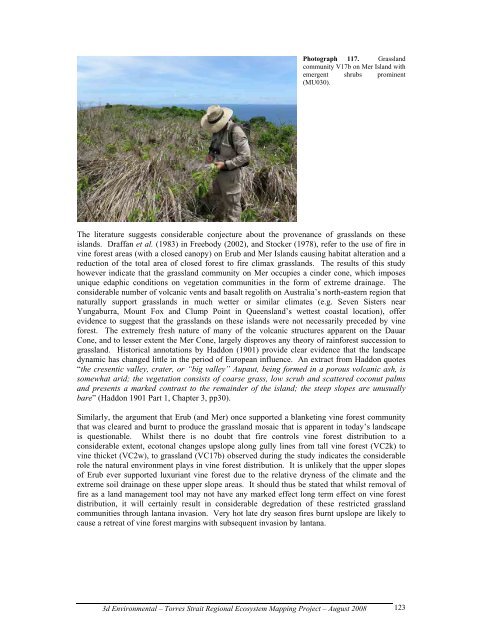Appendix 2 - Vegetation Communities and Regional Ecosystems
Appendix 2 - Vegetation Communities and Regional Ecosystems
Appendix 2 - Vegetation Communities and Regional Ecosystems
You also want an ePaper? Increase the reach of your titles
YUMPU automatically turns print PDFs into web optimized ePapers that Google loves.
Photograph 117. Grassl<strong>and</strong><br />
community V17b on Mer Isl<strong>and</strong> with<br />
emergent shrubs prominent<br />
(MU030).<br />
The literature suggests considerable conjecture about the provenance of grassl<strong>and</strong>s on these<br />
isl<strong>and</strong>s. Draffan et al. (1983) in Freebody (2002), <strong>and</strong> Stocker (1978), refer to the use of fire in<br />
vine forest areas (with a closed canopy) on Erub <strong>and</strong> Mer Isl<strong>and</strong>s causing habitat alteration <strong>and</strong> a<br />
reduction of the total area of closed forest to fire climax grassl<strong>and</strong>s. The results of this study<br />
however indicate that the grassl<strong>and</strong> community on Mer occupies a cinder cone, which imposes<br />
unique edaphic conditions on vegetation communities in the form of extreme drainage. The<br />
considerable number of volcanic vents <strong>and</strong> basalt regolith on Australia’s north-eastern region that<br />
naturally support grassl<strong>and</strong>s in much wetter or similar climates (e.g. Seven Sisters near<br />
Yungaburra, Mount Fox <strong>and</strong> Clump Point in Queensl<strong>and</strong>’s wettest coastal location), offer<br />
evidence to suggest that the grassl<strong>and</strong>s on these isl<strong>and</strong>s were not necessarily preceded by vine<br />
forest. The extremely fresh nature of many of the volcanic structures apparent on the Dauar<br />
Cone, <strong>and</strong> to lesser extent the Mer Cone, largely disproves any theory of rainforest succession to<br />
grassl<strong>and</strong>. Historical annotations by Haddon (1901) provide clear evidence that the l<strong>and</strong>scape<br />
dynamic has changed little in the period of European influence. An extract from Haddon quotes<br />
“the cresentic valley, crater, or “big valley” Aupaut, being formed in a porous volcanic ash, is<br />
somewhat arid; the vegetation consists of coarse grass, low scrub <strong>and</strong> scattered coconut palms<br />
<strong>and</strong> presents a marked contrast to the remainder of the isl<strong>and</strong>; the steep slopes are unusually<br />
bare” (Haddon 1901 Part 1, Chapter 3, pp30).<br />
Similarly, the argument that Erub (<strong>and</strong> Mer) once supported a blanketing vine forest community<br />
that was cleared <strong>and</strong> burnt to produce the grassl<strong>and</strong> mosaic that is apparent in today’s l<strong>and</strong>scape<br />
is questionable. Whilst there is no doubt that fire controls vine forest distribution to a<br />
considerable extent, ecotonal changes upslope along gully lines from tall vine forest (VC2k) to<br />
vine thicket (VC2w), to grassl<strong>and</strong> (VC17b) observed during the study indicates the considerable<br />
role the natural environment plays in vine forest distribution. It is unlikely that the upper slopes<br />
of Erub ever supported luxuriant vine forest due to the relative dryness of the climate <strong>and</strong> the<br />
extreme soil drainage on these upper slope areas. It should thus be stated that whilst removal of<br />
fire as a l<strong>and</strong> management tool may not have any marked effect long term effect on vine forest<br />
distribution, it will certainly result in considerable degredation of these restricted grassl<strong>and</strong><br />
communities through lantana invasion. Very hot late dry season fires burnt upslope are likely to<br />
cause a retreat of vine forest margins with subsequent invasion by lantana.<br />
3d Environmental – Torres Strait <strong>Regional</strong> Ecosystem Mapping Project – August 2008<br />
123


